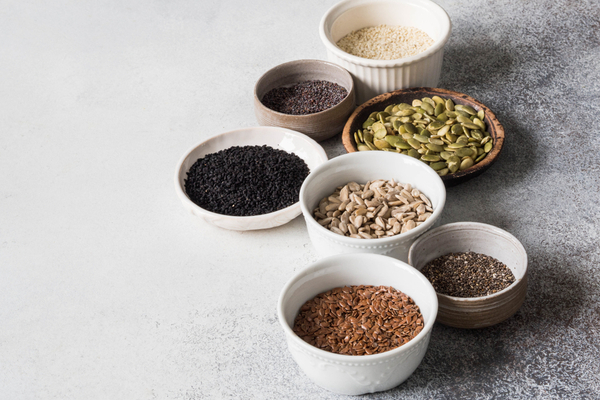When it comes to “superfoods,” you’ve heard all about nuts, but what about seeds? These precious little packages of nutrient glory are popping up everywhere, and for good reason. They’re nutritional powerhouses—loaded with dietary fiber, protein, healthy fats, vitamins, minerals, and antioxidants. There are many different types of seeds to choose from, and they’re easy to incorporate into a variety of dishes, adding a boost of flavor, nutrition, and crunch. Here’s your guide to the whys and hows of seven super seeds.
Chia Seeds. The chia seed has stolen the limelight lately on the supermarket red carpet, showing up in everything from energy bars to cereals to beverages. Chia comes from a desert plant in Mexico called Salvia hispanica and is packed with omega-3 fatty acids, carbohydrates, protein, dietary fiber, antioxidants, and calcium. These tiny black and white seeds were used long ago by Mayan and Aztec cultures to boost energy. Because they have a mild, nutty flavor, chia seeds are easy to add to a variety of foods and drinks. When mixed with water they create a gel that’s touted to be a weight-loss pudding that helps control hunger, however studies have yet to confirm this benefit.
Flaxseeds. Cultivated in Babylon as early as 3000 BC, flaxseeds have long been known to provide medicinal benefits. Rich in omega-3 fatty acids, dietary fiber, and lignans (beneficial plant compounds), recent studies show flaxseeds may help reduce belly fat and lower your risk of heart disease, cancer, stroke, and diabetes. Flaxseeds are widely available in products such as frozen waffles, cereals, and meatless meal products. When adding them to foods it’s best to eat them in the ground form for better absorption of the nutrients. You can easily grind them yourself in an electric coffee grinder.
Sesame Seeds. Sesame seeds aren’t just for hamburger buns. Popular in many Asian dishes, sesame seeds add a nutty taste and a delicate crunch to whatever you’re making. They’re also used to make sesame paste or tahini, which can be spread on crackers or toast and often used in Middle Eastern dishes to make hummus and falafel. These powerhouse seeds provide calcium, iron, magnesium, phosphorus, zinc, B vitamins, and dietary fiber. Due to their antioxidants, a recent animal study showed sesame oil may help lower inflammation and improve brain health.
Pumpkin Seeds. The pumpkin plant, along with its seeds, has been used in the traditional medicine of many countries, including India and Mexico. Pumpkin seeds promote good prostate health and offer anti-inflammatory and cholesterol-lowering benefits. Subtly sweet and nutty with a somewhat chewy texture, pumpkin seeds are lower in fat than other seeds and offer essential minerals like iron, magnesium, and potassium. Pumpkin seeds also contain protective compounds called phytosterols, which likely contribute to their known prostate and heart health benefits. While available year round, they are freshest in the fall when pumpkins are in season.
Sunflower Seeds. This stadium favorite is a home run for nutritional benefits. Small but mighty, sunflower seeds are an excellent source of protein, iron, folate, zinc, dietary fiber, and vitamin E. In fact, sunflower seeds are the best whole-food source of vitamin E, a nutrient that may slow the effects of aging, boosts the immune system, and prevents cardiovascular disease. They are also packed with four times more antioxidants than blueberries, walnuts, and peanuts, boosting the immune system and lowering blood pressure and bad cholesterol.
Hemp Seeds. Hemp foods are expanding on the shelves of grocery and natural food stores in everything from salad dressings to chips to frozen desserts, being promoted by marketers for their exemplary nutritional and taste benefits. The hulled version of the seed is soft and easy to chew and tastes a bit like pine nuts or sunflower seeds. Hemp seeds are an excellent source of essential fatty acids and contain all nine essential amino acids, making them a complete protein source. Plus, the protein in hemp seeds is very easy to digest.
Wheat Germ. Wheat? On a seed list? Well, wheat germ is actually the part of a grain that will develop into a seed. For refined grains like white bread and most snack foods, the germ is removed so you only get the starchy endosperm. This is unfortunate since the germ (meant to feed the new plant) is a highly concentrated source of nutrients, including niacin, thiamin, riboflavin, folate, vitamin E, magnesium, phosphorus, potassium, iron, and zinc. Wheat germ also provides dietary fiber and healthy fats to help balance blood sugar levels, control cholesterol levels, and promote intestinal health.
—
Photo Credit: Sentelia / Shutterstock.com
